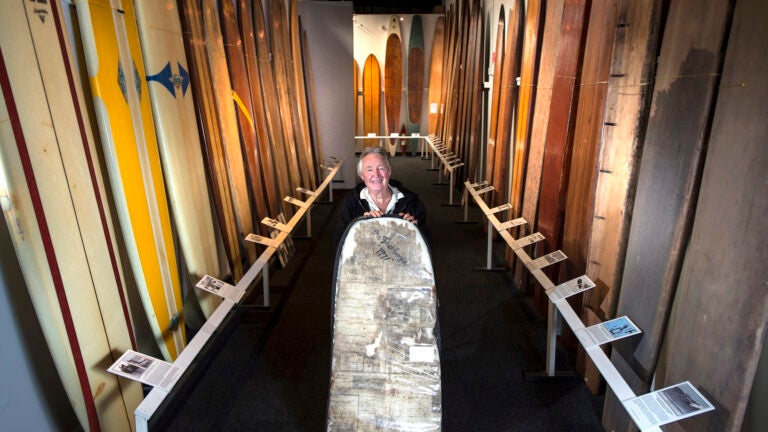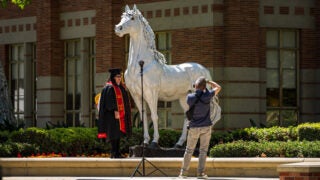
Tom Morey, inventor of the Boogie board, shows off the first board he ever made at the Surfing Heritage & Culture Center in San Clemente in 2015. (Photo/Courtesy of Ed Crisostomo of The Orange County Register, SCNG)
Tom Morey, 86, surfing legend and Boogie board inventor
The USC alumnus invented other surf devices, toys and games, but his Boogie board creation became a smash hit for beachgoers.
Surfer, inventor and musician Tom H. Morey, known for creating the ubiquitous Boogie board, died on Oct 14. He was 86.
Morey’s squat foam board revolutionized the surfing industry in the 1970s, turning the tricky task of wave riding into an accessible sport for the beachgoing masses. Millions of boards based on his original design have been sold, creating one of the world’s most popular watersports and spawning professional competitions.
Morey’s bachelor’s degree in mathematics from the USC Dornsife College of Letters, Arts and Sciences and knowledge from several engineering and manufacturing jobs helped him invent a steady stream of unusual surfing-related items. None captured the public’s imagination quite like the Boogie, described by Sports Illustrated in 1982 as “a sort of proletarian surfboard.”
The same article noted Morey had also invented a “new kind of Mylar toothpick, a circular book, an improved football, a sailboat with an adjustable mast, three-player chess and Ping-Pong games.” His skill with plastic foam wasn’t limited to bodyboards and surfboards; he shaped it into deck chairs, life preservers and even a ukulele with a fiberglass shell.
“Almost everything has not been invented yet,” he told the magazine. “Some people think of one or two new things in their lifetime. I have the misfortune of being a fabulous inventor.”
Born in 1935, Morey moved with his family from Detroit — where their distant relatives included the Dodge automotive family — to Laguna Beach, Calif. He quickly became an avid bodysurfer, riding waves on his father’s back at age 8 and winning second place in a paddleboard competition as a preteen.
He also embraced music, performing solo shows on the drums by age 12, joining the Sons of the Beach ukulele band in 1950 and forming the Tom Morey Jazz Quartet in 1954. The following year, his quartet won an award for the best college jazz band. While at USC, he collaborated with classmate Bob Tierney to invent the Fantopper paper hat, which drew some interest but ultimately failed to catch on as a fashion trend.
Shortly after graduating in 1957, Morey married his first wife, Jolly, and had two daughters, Michelle and Melinda. After a string of manufacturing jobs, first with Douglas Aircraft Company as a process engineer, then in various positions involving composite materials, he returned to the surf world in 1964, moving to Ventura to open Tom Morey Skeg Works. There he invented the first commercial interchangeable fin system, allowing surfers to swap out damaged fins.
Morey’s success allowed him to host the Tom Morey Invitational Nose Riding Championships at the famed California Street surf break in Ventura, generally recognized as the world’s first professional surfing contest. He offered the winner a $1,500 prize; the following year, the top prize was $5,000.
In 1965, he teamed up with Karl Pope to launch Morey-Pope Surfboards. Their inventions included the Trisect, a three-piece surfboard that could fit in a suitcase, and other boards with quirky titles like the Eliminator and Bob Cooper’s Blue Machine.
Boogie board invention caps a lifetime of creativity for USC alum Tom Morey
During a surf session at Doheny State Beach in the late 1960s, Morey spotted a surfer on a short homemade board crafted from wide foam logs. Although the shape struck Morey as unwieldy, the idea seemed neat.
Around that time, he embraced transcendental meditation and the Bahá’í Faith, a religion that emphasizes the spiritual unity of humankind. He handed over his share of the business to his partner, moved to Hawaii and formed a jazz band. He married his second wife, Marchia, and had four sons, Sol, Moon, Sky and Matteson. Asked why the trend of celestial names stopped at their third son, Morey told Sports Illustrated, “Sky’s the limit.”
Tinkering with surfboard shapes remained an ongoing hobby, and one day he sliced a 9-foot piece of polyethylene foam in half. Using an iron pressed against pages of the Honolulu Advertiser, he shaped the foam into a block approximately 2 feet by 4.5 feet with a rounded nose and square tail. The next day, he paddled out into windswept surf.
“I could actually feel the wave through the board,” he told Surfer magazine. “On a surfboard, you’re not feeling the nuance of the wave, but with my creation, I could feel everything. I was thinking, ‘It turns, it’s durable, it can be made cheaply, it’s lightweight, it’s sage. God, this could be a really big thing.’”
By 1971, he had trademarked the name Morey Boogie and started shaping boards in his backyard, selling them for $37 in honor of his age. Three years later, he was selling his invention out of a shop in Carlsbad, Calif., and the snub-nosed boards soon became a common sight on local beaches.
Demand began to outpace Morey’s ability to manufacture the popular item, and he sold the name and design to a San Francisco company, which later passed the product on to Mattel Toys and then Wham-O. Although Morey remained connected to his famous invention as a consultant, he shifted back to the manufacturing world in 1985, taking a job with Boeing in Bainbridge Island, Washington, to work again with composite materials.
Seven years later, having tired of the rainy and cold Northwest, he returned to Southern California and reentered the surf scene. In 2005, he earned a star on the Huntington Walk of Fame, and he was inducted into the Surfing Hall of Fame.
In 2007, he collaborated with Catch Surf, a soft-top surfboard manufacturer, to create high-performance surfboards that resembled the long, unwieldy boards most beginners start out using but built to professional standards. A review of one of Morey’s models by Surfline stated that it “surfed like a champ.”
Ten years later, Morey was still at it, this time helping with a decadeslong project to honor surfboard shapers by carving ancient sequoia wood into their trademark shapes. At age 81, he helped form those familiar contours and then, using a hot branding iron, charred his name into the fine-grained redwood, a stark symbol of his lasting imprint on the surfing world.



